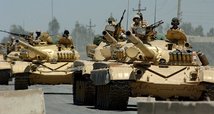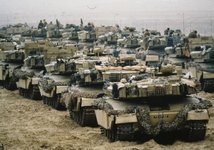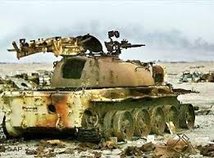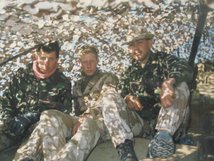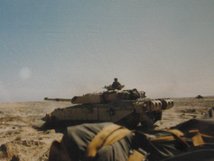MILITARY HISTORY - GULF WAR 1990 - 1991
|
HILLMILITARYMEDALS.CO.UK On August 2nd 1990 The Iraqi dictator Saddam Hussain decided to invade the Small but wealthy Country of Kuwait and take over the vast reserves of oil. Kuwait had been lending Iraq finances to re-build its army after the Iran - Iraq 10 year war. With this invasion the Iraqis commited many crimes and public executions along with torture and general piliging of Kuwait. The United Nations gave Iraq an Ultimatem to withdraw military forces from Kuwait. The deadline come and passed and despite negiotations from the US and Russia to come to an amicable solution this was ignored. The international call went out for help and 23 countries pledged support to assist with military personnel, aid, logistical and intelligence support. In Early August 1990 the Allies Including Canada, UK and USA put in a monitoring force and other countries followed suit. By Christmas 1990 the coalition had massed 7,000 combat forces (mainly United states) and continued to rapidly increase its Military force. By the 2nd week of January 1991 the allies had massed 956,600 men (700,000 of whom were from the USA),with tanks and equipment and aclimatised to the weather and were ready to go. The Iraqi Army was the 4th Largest Army in the World (at the time) 955,000 Iraqi regular army and 655,000 paramilitary (non regular reserve) and 45,500 tanks. Top Picture showing the Iraqi Armies Elite Republican Guard Tanks - The T-72's in 1990 (before they were mauled by British Challenger 1 Tanks including the Hussars and American M1A1 Abrahams. 2nd Picture showing The British Challenger 1 tanks (Challies) at a form up point "RV" pre 14th Jan 1991. 3rd Picture shows a completely destroyed Iraqi main battle tank. (Hit by a plutonium round). 4th Picture showing 3 members of my Warrior crew of a Grenadier Guards Warrior IFV - "Tricky Dicky" Richard Healy "Big Trev" Trevit and Me "Niffy" Tim Hill sat on my wagon under a tank netting pre attacks. (Note the lack of proper desert boots and Desert kit). 5th Picture showing a Challenger 1 from the Queens Royal Hussars one of our support Tanks 7th Armoured Brigade (Desert Rats). 6th Picture showing a fully loaded rear view of a Warrior IFV. British Gulf War 1990 - 1991. British Army - 4th & 7th Armoured Brigades. Around 33,000 British men and women were deployed but only about 7,700 combatant troops (front line) received the bar 16th Jan-28th Feb 1991 on their medals . Regiments Include - Special Air Service (SAS), Special Boat Service (SBS), Staffordshire Regt, Royal Scots, Queens Royal Hussars, Royal Artillery, Grenadier Guards, Scots Guards, Royal Logistic Corps, Royal Signals, Royal Engineers, Royal Electrical Mechanical Engineers to name a few. Royal Navy - Royal Air Force - The Royal Air force were the first to start the attack on the infrasture and then on the front line and defensive positions with the role of neutralising as many tanks and positions as possible to allow the mechanised and infantry attacks. The use of low level tornados and smart bombs with an array of possible weapons was possible after the Iraqi airforce was first shot down with some MIGS flying to Iran (the country they had been at war with for 10 years) and Air supremacy allowed the Allies freedom of movement on the ground. This was the first time the British Apache crews tested their helicopters in combat and the first time "The Desert Rats" fought in the desert since North Africa 1942. The use of modern technology assisted the Allies in defeating the Iraqi Armed forces including the Medina and Republican Guard Divisions in the Air and on the Ground with the Royal Artillerys MRLS and artillery hammering enemy positions day and night and constant air attacks. On the 16th January 1991 the long awaited ground war started and after the berms and anti tank ditches had been filled in by the Combat Engineers The Army attacked lead by Challenger Tanks (Challies) and Warrior IFV Tanks and Infantry Crews. The British Army didnt lose a single Challenger tank in the whole war from enemy fire and the superior British Challenger and American M1 Abrahams Tanks were able to outgun their opponents whilst having the ability to accuratly fire on the move and from further distances. They mauled Iraqi tanks time and time again in every battle they meet and showed that the Iraqi Armies tanks were no match for the allies. This was supported by allied infantry, artillery and total air cover by the Royal Air Force and Army Air Corps and USAF. Which gave the allies space to manouver and attack. The American Air attacks (Primarily Apache Helicopters) on the Basra road was "the nail in the coffin" and the Iraqi army ceased to be a fighting cohesive force. Whilst fleeing many soldiers stole buses and vehicles to escape the advancing troops which was the end of the Iraq aggresion and on the 28th Feb 1991 it was declared over and Kuwait was liberated and a free Country again. Coalition Service personnel Killed - 47 British. 294 American, 9 French. 92 Senegal (Fatal Accident), 24 Saudi Arabia, 1 Kuwait, 11 Egypt, 2 Syria. The true figure is unknown of how many Iraqi Soldiers were killed but experts estimates put it between 20,000 and 26,000 Iraqi military personnel killed in the conflict while 75,000 others were wounded and an astonishing estimated 111,400+ Iraqi Soldiers taken prisoner. Allied Countries involved - United States of America (Including USMC), United Kingdom (Including SAS & SBS), Australia, Belgium, Canada, France 18,000 Men (Including French Foreign Legion), Egypt. Germany, Holland, Kuwait, Quatar, Saudi Arabia, Senegal, UAE. On a Lighter note - The Americans took charge of part of the surrender and the American Brigade commander had an iraqi brigade commander in his tank finalising terms of surrender, The Iraqi commander who spoke in English asked "Why do you have a picture of your WW2 adversary Rommel in the back of your tank" To which the American commander replied "If you had spent more time studying his tactics you wouldnt be sat in the back of my tank". HILLMILITARYMEDALS.CO.UK |


 Facebook
Facebook
